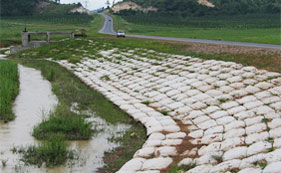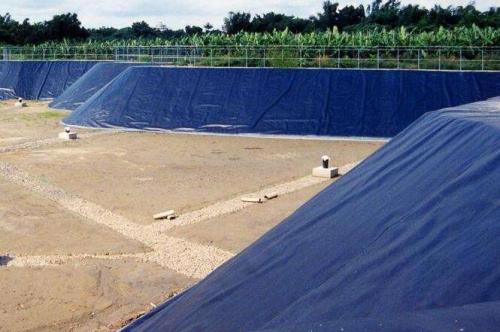
 Back to List
Back to List

1. Before laying HDPE geomembrane, the corresponding qualified acceptance certificate of civil engineering should be obtained.
2. Before cutting HDPE geomembrane, the relevant dimensions should be accurately measured and then cut according to the actual size. Generally, it is not advisable to cut according to the size shown in the figure. It should be numbered piece by piece and recorded in detail on the special form.
3. When laying HDPE geomembrane, there should be fewer welds, and the raw materials should be saved as much as possible under the premise of ensuring quality. It is also easy to ensure quality.
4. The lap width of the seam between the film and the film is generally not less than 10cm, usually the welding seam arrangement direction is parallel to the larger slope, that is, arranged along the slope direction.
5. Usually in corners and deformed areas, the length of the joint should be as short as possible. Except for special requirements, on slopes with a slope greater than 1:6, within 1.5 meters from the top slope or stress concentration area, there should be no welds as far as possible.
6. During laying, HDPE geomembrane should avoid artificial wrinkles. When the temperature is low, it should be tightened and flattened as much as possible.
7. After the HDPE geomembrane is laid, it is necessary to reduce walking and moving tools on the surface of the membrane as much as possible. Anything that can cause harm to the impermeable membrane should not be placed on the membrane or carried on the membrane to avoid damage The membrane causes accidental damage.
welding
1. The welding process of the hot wedge welding machine is divided into: adjusting the pressure, setting the temperature, setting the speed, inspecting the weld overlap, installing the film into the machine, starting the motor, and pressure welding.
2. There should be no oil and dust at the joints, and there should be no debris such as mud and sand on the overlapping section of the HDPE geomembrane. When there is debris, it must be cleaned up before welding.
3. At the beginning of each day of welding, a test piece of 0.9mm×0.3mm must be welded on site, with a lap width of not less than 10cm, and peel and shear tests on site with a tensile machine. After the sample is qualified, it can be adjusted at that time Good speed, pressure, and temperature are just welding. The date, time, and ambient temperature must be marked on the sample. During the welding process of the hot wedge welding machine, it is necessary to pay attention to the operation of the welding machine at any time, and fine-tune the speed and temperature according to the actual situation on the spot.
4. The welding seam is required to be neat and beautiful, without slip welding or skipping.
5. When the length of the geomembrane is not enough, it needs to be spliced in the long direction. The transverse welds should be welded first, and then the longitudinal welds. The distance between the transverse welds is greater than 50cm, and they should be in a T-shaped shape and not cross.
6. Adjacent geomembrane welds should be staggered and overlapped as much as possible. The junctions formed between the membrane blocks should be T-shaped, and cross-shaped should be minimized. The longitudinal die should be used to strengthen the intersection of the weld.
7. When welding the film, it is not allowed to press out dead bends. When laying HDPE geomembrane, set aside the amount of expansion and contraction caused by temperature changes according to the local temperature change range and HDPE geomembrane performance requirements.
8. When the temperature of the welder indicated by the temperature control of the portable welder is lower than 200℃, wipe it off with a clean cloth or cotton yarn and re-solder. If necessary, it should be re-polished. Avoid hand rubbing.
9. When the joints are affected by condensation, moisture, mud, etc., welding should be carried out after treatment.
10. Welding cannot be carried out during rain or when there is moisture, dew, or heavy sand in the joints, unless protective measures are taken.
11. When the temperature is lower than 5℃, construction should not be carried out in accordance with the specifications. If construction is required, the welding machine should be preheated before welding.
12. In the welding process of extrusion welding machine, the slider of the gun head should be checked frequently, and the slider should be replaced in time when the wear is serious to avoid damage to the film surface.
13. The geomembrane should be powered by a generator with good voltage stabilization performance when welding, and a voltage stabilizer should be used when local electricity is used in special circumstances.
Special treatment
1. The intersection of the slopes is the corner of the dam slope: laying and welding are special circumstances, and they must be specially cut according to the actual conditions to make the geomembrane close to the dam slope base, otherwise it will cause "hanging" or "bulging" phenomenon.
Construction key points: In this area, the operator must carefully measure and cut the geomembrane into an inverted trapezoid with a wide upper and a narrow lower.
2. At the intersection of the slope of the reservoir area and the bottom of the reservoir, there are many blind trenches in the design.
Construction key points: First, lay the geomembrane along the dam surface 1.5 meters away from the blind ditch
Then connect with the bottom membrane of the library; the welding of the two adjacent panels is: after welding, press into the blind groove.
3. The connection of the dam pipe and the geomembrane: first cut the HDPE geomembrane into horn-shaped pipe sleeves according to the diameter of the leachate penetrating the dam pipe, and divide them into 6-8 pieces, and then arrange the pipe sleeves in descending order Sleeve into the dam-piercing pipe, adjust the position of the pipe sleeve appropriately and temporarily fix it with a hot-air torch. The pipe sleeve cannot have any suspended parts. After that, the large and small sleeves of the pipe sleeve are welded to the HDPE geomembrane and the leachate through the dam pipe, and reinforced with stainless steel hoop.